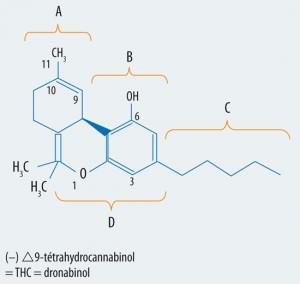
With hundreds of compounds, the Cannabis plant is fascinating in its enormous variety of chemicals. According to the Americans for Safe Access (ASA), there are over 483 different identifiable chemical constituents known to exist in cannabis, of which over 80 are unique to the cannabis plant. These constituents include nitrogenous compounds, amino acids, proteins, glycoproteins, enzymes, sugars and related compounds, hydrocarbons, alcohols, acids, esters, aldehydes, ketones, fatty acids, lactones, steroids, terpenes, non-cannabinoid phenols, flavonoids, vitamins, pigments and elements.
One of the compounds, delta-9-tetrahydrocannabinol (Δ9-THC or THC), was isolated and synthesized in 1964 by Mechoulam and Gaoni at the Weizmann Institute of Science, and is clearly the most pharmacologically active and most potent psychoactive cannabinoid.
The active agent in Cannabis is unique among psychoactive plant materials in that it contains no nitrogen and thus is not an alkaloid. Because Cannabis lacks nitrogen, the 19th century chemists who had been so successful in isolating the active agents from other plants were unable to identify its active component. All cannabinoids present in the plant are in their acid (2-COOH) form, such as tetrahydrocannabinolic acid or THCA and CBDA (acid form B also exists, but in much smaller quantities than A). These cannabinoids undergo decarboxylation during heating which transforms them into active forms of THC, CBD, etc.
The terms “cannabinoids” and “phytocannabinoids” generally refer to a group of C21 terpenophenolic compounds. Cannabinoids are generally aryl-substituted monoterpenes that are lipid soluble and neutral. The cannabinoids are divided into 10 closely related classes, many of which differ by a single chemical moiety.
The concentration of tetrahydrocannabinol (THC) in marijuana can range from 0.5% to 20%. Hashish consists of dried cannabis resin and compressed flowers with THC ranges from 2% to more than 20%. Oils prepared from marijuana or hash using an organic solvent to extract THC produce concentrations between 15% and 70%. Waxes made from cannabis, called “budder,” form a potent cannabis concentrate that can exceed 99% THC. As aromatic terpenoids, cannabinoids have very low solubility in water but good solubility in most organic solvents, lipids, and alcohols.
THC has a boiling point of 200˚C, specific rotation (20) of -150.5˚ (c= 0.53 in CHCl3) and a UV maximum (in ethanol) of 283 (log ɛ = 3.21) and 276 (log ɛ = 3.20).
©2024 MEDICINAL GENOMICS CORPS
Copyright all right reserved.
Signup to receive email updates on blog posts, podcasts, webinars, new products, and more!
Join us at the CannMed 24 Innovation and Investment Summit, an exclusive experience of discovery, development, and networking with innovators from around the world.